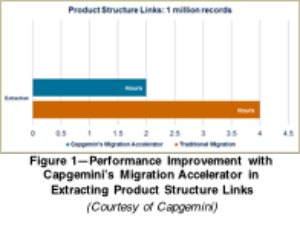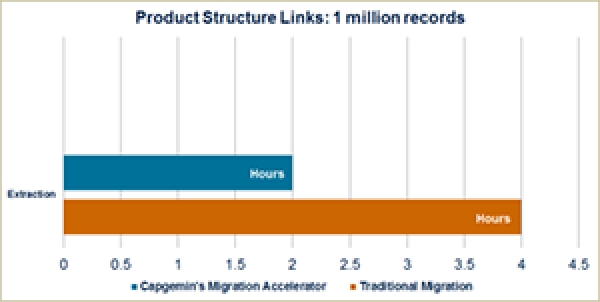Key takeaways:
- M&A activities result in the need for an enterprise PLM backbone, unifying all product design assets across disparate business units.
- PLM transformations require large scale data migrations, which are often the highest risk, most over budget process in moving to a consolidated PLM platform.
- Using an open source toolset enables agility and multiple implementation options for PLM migrations; decreasing overall PLM implementation schedule risk and cost
In today’s economy, organizational realignments, mergers, acquisitions, technological upgrades, and security enhancements are all motivating factors for firms to consolidate and upgrade legacy and current PDM and other PLM-enabling solutions. The result is a need for data and process migration, from legacy and internal systems to a currently supported, ideally non-customized, PLM-enabling solution. CIMdata observes that data migrations are the most underestimated and under resourced part of PLM implementations, and often the highest risk factor in delaying the implementation and increasing overall implementation costs. Improving data migration predictability, minimizing costs, and shortening schedules result in direct bottom line savings for the PLM implementation.
Data migrations usually employ one of three alternative approaches. These are:
- PLM provider migration tool—the PLM provider offers a toolset for data and metadata migration into their latest supported PLM offering. This approach rarely encompasses support for other PLM systems, or CAD and other data set offers that are not directly sold by the PLM provider. The result is “holes” in the coverage provided by the migration tool.
- Semi-manual migration with a low cost service provider—Working with off-site staff, a service provider may be employed to migrate the data using labor intensive efforts to perform the data migration. This approach suffers from high dependence upon existing in-house support staff in documenting, monitoring, and quality checking the resultant migration activities.
- Do-it-yourself—Using internal PLM and IT resources, for this, the labor costs may not be immediately visible when investigating migration choices. Even in the cases where the PLM and IT resources are available, companies should ask themselves about the lost opportunity costs of using these internal resources—what else could they have accomplished instead of a PLM migration?
All of these migration approaches have major shortcomings, and do little to lessen the overall risk and cost of PLM migration activities.
Capgemini has developed another alternative for PLM migrations. Leveraging its program experiences with major PLM platforms, Capgemini has built a suite of tools—Capgemini’s Migration Accelerators. An important part of this set is a tool built using open source real-time data integration technology from Talend. Capgemini’s solution offers the capability to enhance the Extract-Transform-Load-Verify (ETLV) processes for PLM data migration with significant business benefits.
Migration tools provided by the ISVs are robust but unidirectional in functionality and teams need to adopt other aspects, either manual or tools-based, to complete the overall migration strategy. The approach of using Talend has helped in overcoming the widely encountered deficiencies of traditional migration tools. The experience as an independent PLM Systems Integrator helps Capgemini aggregate the challenges from a variety of PLM landscapes and identify opportunities of automation across the data migration process. Capgemini selected an open source technology to bring in the flexibility needed for tweaking the tool to the complexity of each PLM landscape while reducing the dependency on ISV or expensive third party tools.
 Capgemini’s Migration Accelerator has been deployed to migrate dissimilar PLM systems, in the case below (Figure 2) multiple locations, on multiple PLM and CAD offerings into a single enterprise PLM system. The primary goal achieved with the tool is cost effective migration of existing legacy PLM and non-PLM data. When used in tandem with the ISV provided tools Capgemini’s approach extends the value of automation beyond the ISV defined technical limitations. Capgemini has saved up to 50% time over traditional methods (Figure 1) during data extraction and transformation, resulting in overall acceleration of the entire migration process. Efficiency is improved in quality management of migrated data through automation.
Capgemini’s Migration Accelerator has been deployed to migrate dissimilar PLM systems, in the case below (Figure 2) multiple locations, on multiple PLM and CAD offerings into a single enterprise PLM system. The primary goal achieved with the tool is cost effective migration of existing legacy PLM and non-PLM data. When used in tandem with the ISV provided tools Capgemini’s approach extends the value of automation beyond the ISV defined technical limitations. Capgemini has saved up to 50% time over traditional methods (Figure 1) during data extraction and transformation, resulting in overall acceleration of the entire migration process. Efficiency is improved in quality management of migrated data through automation.

Figure 2—Architecture of Capgemini’s Migration Accelerator for the Product Structure Use-Case
(Courtesy of Capgemini)
This approach has the benefits of:
- A toolset providing a high degree of automation for rapid migration.
- Support for complex multi-PLM migration scenarios.
- Building a better case for ROI in PLM transformations through contained costs for data migration. CIMdata experience has been that data migrations are the one of the areas in PLM implementations that are likely to be highly over budget and high risk for deployment delays.
- Improved overall quality of migrated data using Talend for high-level data transformation.
- Rapid data integration with increased ability to analyze and react to architectural requirements.
These components of Capgemini’s Migration Accelerator are regularly enhanced to incorporate lessons learned from programs, thus enabling continuous improvement in the approach. Capgemini has further leveraged the palette and drag and drop features of the native Talend user interface to keep things simple for configuration and usage. CIMdata believes that this augurs well for training consultants and ramping up program requirements.
Migration Accelerator Roadmap
Based on lessons learned during initial use, Capgemini is further extending the use of open source Talend to address more challenges in PLM data migration and integration. By enabling quality review and automating many manual processes, these will result in increased PLM migration quality and performance optimizations. Planned extensions include:
- Increase the impact on data quality -Source data evaluation, prior to conversion activities
- PLM analytics -Schema and data analyzers
-Rule implementation and Automation for quality enforcement on migrated data
-Data rule validation Interactive validation and support for UAT inputs
-Web stack analyzers
-Environment checklist automation, eliminating manual errors often encountered in test and final migration runs
-Automation for migration effort estimate
CIMdata looks forward to seeing how well these roadmap capabilities extend the benefits for users of Migration Accelerator.
Conclusion
In the past, moving to new PLM platforms has usually meant using vendor-supplied toolsets, effectively limiting migration options and increasing migration costs and schedule risks. Through the use of open source migration tools, multiple staffing and schedule choices become available, lessening the risk to migration schedule—and decreasing time to value on the new PLM platform. Capgemini is a global PLM solution provider that can make this vision happen. More information on Capgemini’s Migration Accelerator can be found by contacting Diese E-Mail-Adresse ist vor Spambots geschützt! Zur Anzeige muss JavaScript eingeschaltet sein! .





